Tatsuya Harada
Improved 3D Scene Stylization via Text-Guided Generative Image Editing with Region-Based Control
Sep 04, 2025Abstract:Recent advances in text-driven 3D scene editing and stylization, which leverage the powerful capabilities of 2D generative models, have demonstrated promising outcomes. However, challenges remain in ensuring high-quality stylization and view consistency simultaneously. Moreover, applying style consistently to different regions or objects in the scene with semantic correspondence is a challenging task. To address these limitations, we introduce techniques that enhance the quality of 3D stylization while maintaining view consistency and providing optional region-controlled style transfer. Our method achieves stylization by re-training an initial 3D representation using stylized multi-view 2D images of the source views. Therefore, ensuring both style consistency and view consistency of stylized multi-view images is crucial. We achieve this by extending the style-aligned depth-conditioned view generation framework, replacing the fully shared attention mechanism with a single reference-based attention-sharing mechanism, which effectively aligns style across different viewpoints. Additionally, inspired by recent 3D inpainting methods, we utilize a grid of multiple depth maps as a single-image reference to further strengthen view consistency among stylized images. Finally, we propose Multi-Region Importance-Weighted Sliced Wasserstein Distance Loss, allowing styles to be applied to distinct image regions using segmentation masks from off-the-shelf models. We demonstrate that this optional feature enhances the faithfulness of style transfer and enables the mixing of different styles across distinct regions of the scene. Experimental evaluations, both qualitative and quantitative, demonstrate that our pipeline effectively improves the results of text-driven 3D stylization.
ToolGrad: Efficient Tool-use Dataset Generation with Textual "Gradients"
Aug 06, 2025Abstract:Prior work synthesizes tool-use LLM datasets by first generating a user query, followed by complex tool-use annotations like DFS. This leads to inevitable annotation failures and low efficiency in data generation. We introduce ToolGrad, an agentic framework that inverts this paradigm. ToolGrad first constructs valid tool-use chains through an iterative process guided by textual "gradients", and then synthesizes corresponding user queries. This "answer-first" approach led to ToolGrad-5k, a dataset generated with more complex tool use, lower cost, and 100% pass rate. Experiments show that models trained on ToolGrad-5k outperform those on expensive baseline datasets and proprietary LLMs, even on OOD benchmarks.
Gradual Transition from Bellman Optimality Operator to Bellman Operator in Online Reinforcement Learning
Jun 06, 2025Abstract:For continuous action spaces, actor-critic methods are widely used in online reinforcement learning (RL). However, unlike RL algorithms for discrete actions, which generally model the optimal value function using the Bellman optimality operator, RL algorithms for continuous actions typically model Q-values for the current policy using the Bellman operator. These algorithms for continuous actions rely exclusively on policy updates for improvement, which often results in low sample efficiency. This study examines the effectiveness of incorporating the Bellman optimality operator into actor-critic frameworks. Experiments in a simple environment show that modeling optimal values accelerates learning but leads to overestimation bias. To address this, we propose an annealing approach that gradually transitions from the Bellman optimality operator to the Bellman operator, thereby accelerating learning while mitigating bias. Our method, combined with TD3 and SAC, significantly outperforms existing approaches across various locomotion and manipulation tasks, demonstrating improved performance and robustness to hyperparameters related to optimality.
Detection Based Part-level Articulated Object Reconstruction from Single RGBD Image
Apr 04, 2025


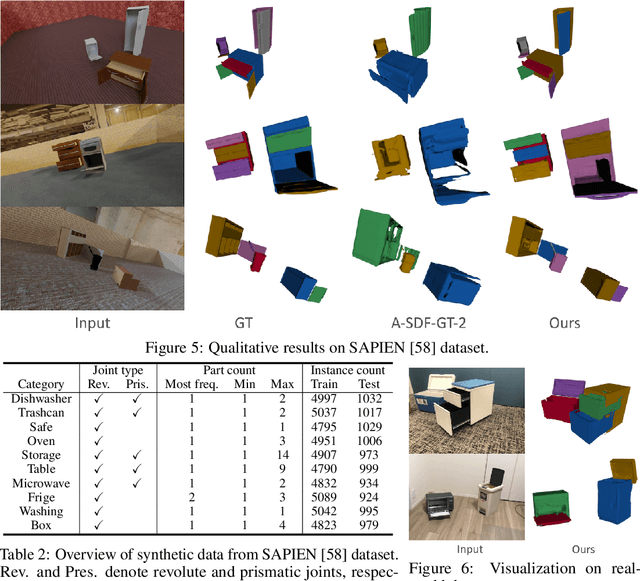
Abstract:We propose an end-to-end trainable, cross-category method for reconstructing multiple man-made articulated objects from a single RGBD image, focusing on part-level shape reconstruction and pose and kinematics estimation. We depart from previous works that rely on learning instance-level latent space, focusing on man-made articulated objects with predefined part counts. Instead, we propose a novel alternative approach that employs part-level representation, representing instances as combinations of detected parts. While our detect-then-group approach effectively handles instances with diverse part structures and various part counts, it faces issues of false positives, varying part sizes and scales, and an increasing model size due to end-to-end training. To address these challenges, we propose 1) test-time kinematics-aware part fusion to improve detection performance while suppressing false positives, 2) anisotropic scale normalization for part shape learning to accommodate various part sizes and scales, and 3) a balancing strategy for cross-refinement between feature space and output space to improve part detection while maintaining model size. Evaluation on both synthetic and real data demonstrates that our method successfully reconstructs variously structured multiple instances that previous works cannot handle, and outperforms prior works in shape reconstruction and kinematics estimation.
Luminance-GS: Adapting 3D Gaussian Splatting to Challenging Lighting Conditions with View-Adaptive Curve Adjustment
Apr 02, 2025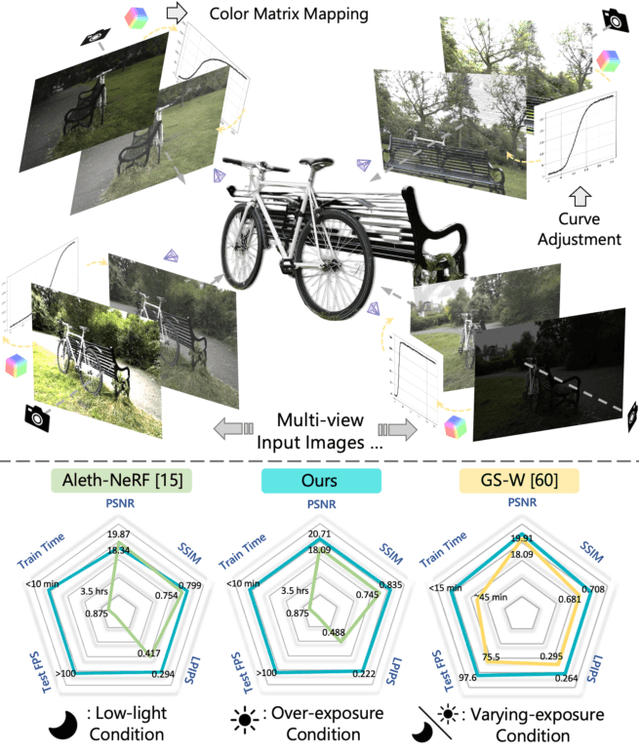
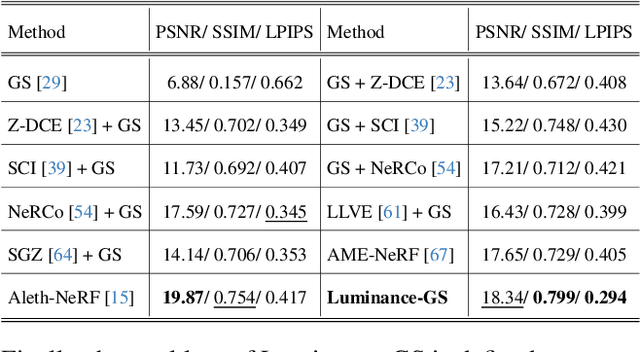
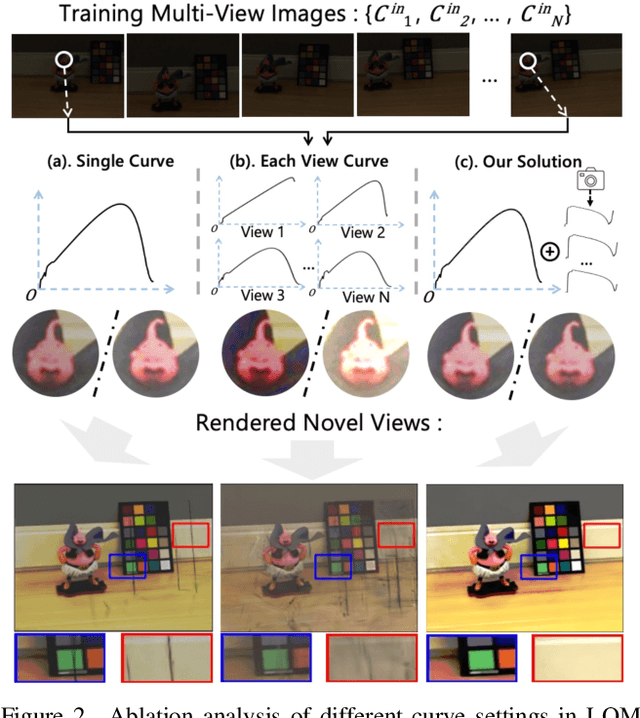
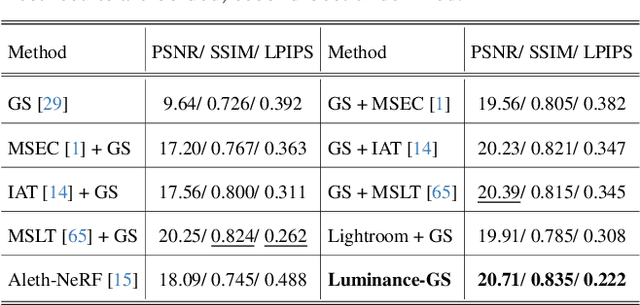
Abstract:Capturing high-quality photographs under diverse real-world lighting conditions is challenging, as both natural lighting (e.g., low-light) and camera exposure settings (e.g., exposure time) significantly impact image quality. This challenge becomes more pronounced in multi-view scenarios, where variations in lighting and image signal processor (ISP) settings across viewpoints introduce photometric inconsistencies. Such lighting degradations and view-dependent variations pose substantial challenges to novel view synthesis (NVS) frameworks based on Neural Radiance Fields (NeRF) and 3D Gaussian Splatting (3DGS). To address this, we introduce Luminance-GS, a novel approach to achieving high-quality novel view synthesis results under diverse challenging lighting conditions using 3DGS. By adopting per-view color matrix mapping and view-adaptive curve adjustments, Luminance-GS achieves state-of-the-art (SOTA) results across various lighting conditions -- including low-light, overexposure, and varying exposure -- while not altering the original 3DGS explicit representation. Compared to previous NeRF- and 3DGS-based baselines, Luminance-GS provides real-time rendering speed with improved reconstruction quality.
Interactive Tumor Progression Modeling via Sketch-Based Image Editing
Mar 10, 2025
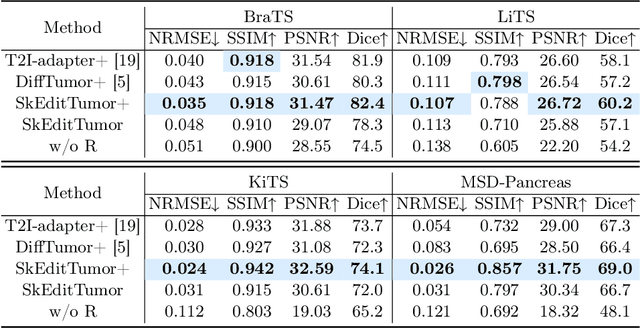
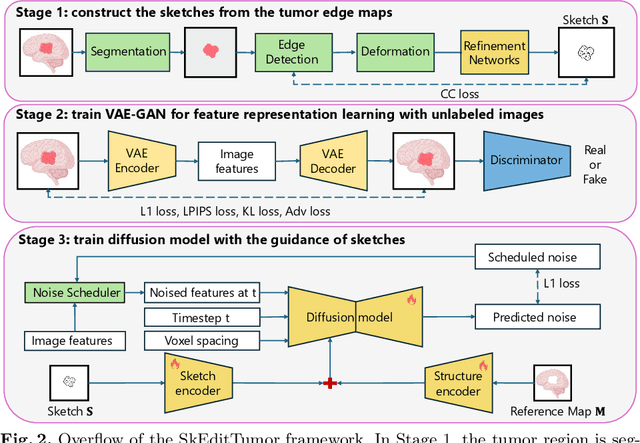
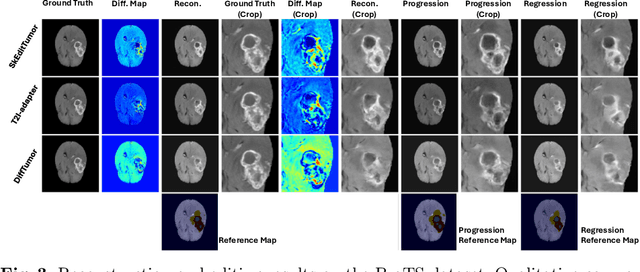
Abstract:Accurately visualizing and editing tumor progression in medical imaging is crucial for diagnosis, treatment planning, and clinical communication. To address the challenges of subjectivity and limited precision in existing methods, we propose SkEditTumor, a sketch-based diffusion model for controllable tumor progression editing. By leveraging sketches as structural priors, our method enables precise modifications of tumor regions while maintaining structural integrity and visual realism. We evaluate SkEditTumor on four public datasets - BraTS, LiTS, KiTS, and MSD-Pancreas - covering diverse organs and imaging modalities. Experimental results demonstrate that our method outperforms state-of-the-art baselines, achieving superior image fidelity and segmentation accuracy. Our contributions include a novel integration of sketches with diffusion models for medical image editing, fine-grained control over tumor progression visualization, and extensive validation across multiple datasets, setting a new benchmark in the field.
ARTalk: Speech-Driven 3D Head Animation via Autoregressive Model
Feb 28, 2025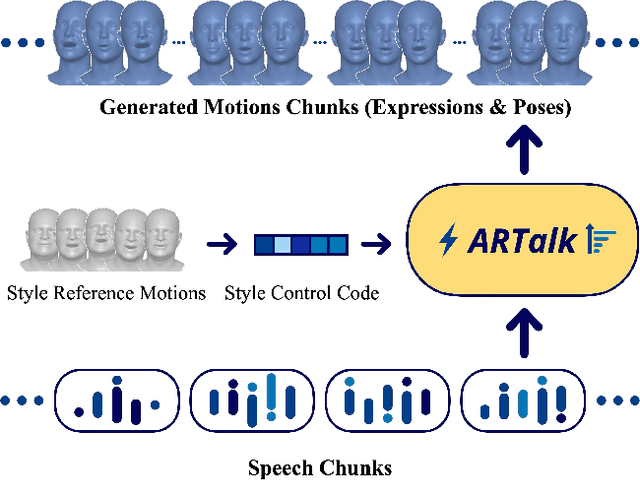
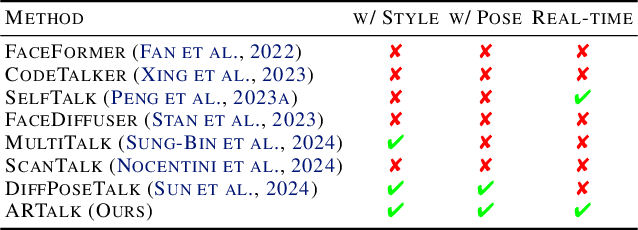
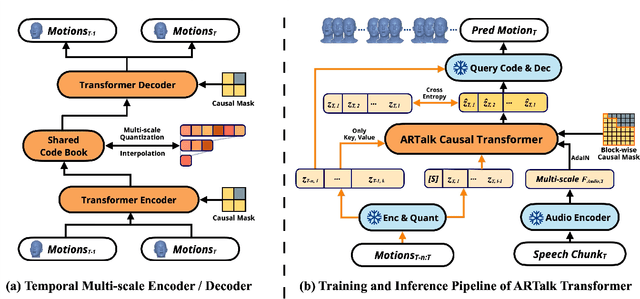
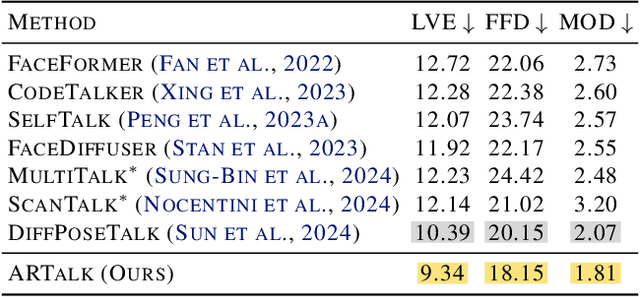
Abstract:Speech-driven 3D facial animation aims to generate realistic lip movements and facial expressions for 3D head models from arbitrary audio clips. Although existing diffusion-based methods are capable of producing natural motions, their slow generation speed limits their application potential. In this paper, we introduce a novel autoregressive model that achieves real-time generation of highly synchronized lip movements and realistic head poses and eye blinks by learning a mapping from speech to a multi-scale motion codebook. Furthermore, our model can adapt to unseen speaking styles using sample motion sequences, enabling the creation of 3D talking avatars with unique personal styles beyond the identities seen during training. Extensive evaluations and user studies demonstrate that our method outperforms existing approaches in lip synchronization accuracy and perceived quality.
Discovering an Image-Adaptive Coordinate System for Photography Processing
Jan 11, 2025Abstract:Curve & Lookup Table (LUT) based methods directly map a pixel to the target output, making them highly efficient tools for real-time photography processing. However, due to extreme memory complexity to learn full RGB space mapping, existing methods either sample a discretized 3D lattice to build a 3D LUT or decompose into three separate curves (1D LUTs) on the RGB channels. Here, we propose a novel algorithm, IAC, to learn an image-adaptive Cartesian coordinate system in the RGB color space before performing curve operations. This end-to-end trainable approach enables us to efficiently adjust images with a jointly learned image-adaptive coordinate system and curves. Experimental results demonstrate that this simple strategy achieves state-of-the-art (SOTA) performance in various photography processing tasks, including photo retouching, exposure correction, and white-balance editing, while also maintaining a lightweight design and fast inference speed.
Emergence of Painting Ability via Recognition-Driven Evolution
Jan 09, 2025Abstract:From Paleolithic cave paintings to Impressionism, human painting has evolved to depict increasingly complex and detailed scenes, conveying more nuanced messages. This paper attempts to emerge this artistic capability by simulating the evolutionary pressures that enhance visual communication efficiency. Specifically, we present a model with a stroke branch and a palette branch that together simulate human-like painting. The palette branch learns a limited colour palette, while the stroke branch parameterises each stroke using B\'ezier curves to render an image, subsequently evaluated by a high-level recognition module. We quantify the efficiency of visual communication by measuring the recognition accuracy achieved with machine vision. The model then optimises the control points and colour choices for each stroke to maximise recognition accuracy with minimal strokes and colours. Experimental results show that our model achieves superior performance in high-level recognition tasks, delivering artistic expression and aesthetic appeal, especially in abstract sketches. Additionally, our approach shows promise as an efficient bit-level image compression technique, outperforming traditional methods.
Paleoinspired Vision: From Exploring Colour Vision Evolution to Inspiring Camera Design
Dec 27, 2024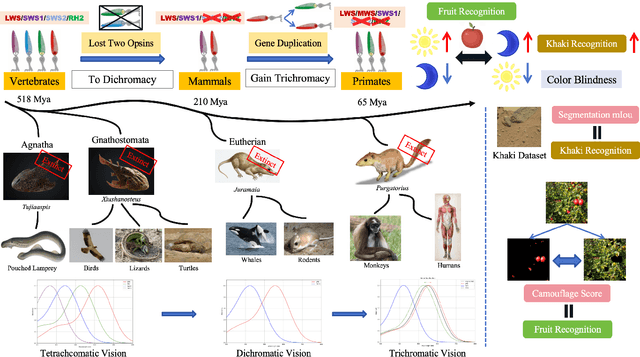
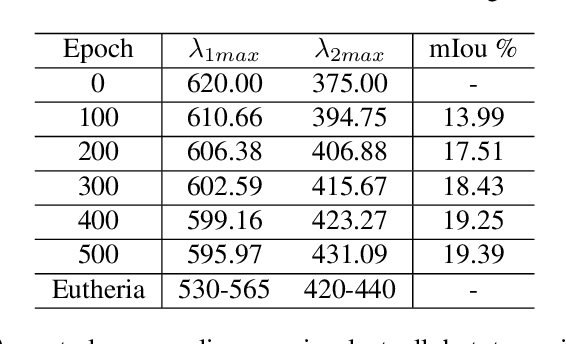
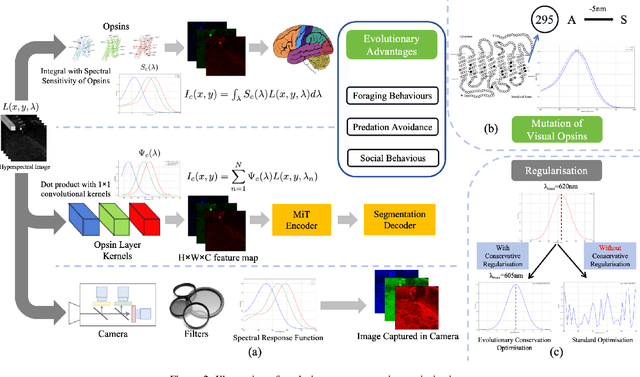

Abstract:The evolution of colour vision is captivating, as it reveals the adaptive strategies of extinct species while simultaneously inspiring innovations in modern imaging technology. In this study, we present a simplified model of visual transduction in the retina, introducing a novel opsin layer. We quantify evolutionary pressures by measuring machine vision recognition accuracy on colour images shaped by specific opsins. Building on this, we develop an evolutionary conservation optimisation algorithm to reconstruct the spectral sensitivity of opsins, enabling mutation-driven adaptations to to more effectively spot fruits or predators. This model condenses millions of years of evolution within seconds on GPU, providing an experimental framework to test long-standing hypotheses in evolutionary biology , such as vision of early mammals, primate trichromacy from gene duplication, retention of colour blindness, blue-shift of fish rod and multiple rod opsins with bioluminescence. Moreover, the model enables speculative explorations of hypothetical species, such as organisms with eyes adapted to the conditions on Mars. Our findings suggest a minimalist yet effective approach to task-specific camera filter design, optimising the spectral response function to meet application-driven demands. The code will be made publicly available upon acceptance.
 Add to Chrome
Add to Chrome Add to Firefox
Add to Firefox Add to Edge
Add to Edge